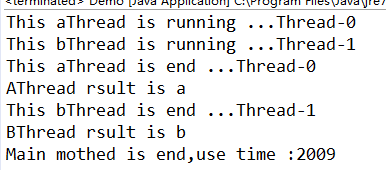join是Thread类的一个方法,启动线程后直接调用,例如:
Thread t = new AThread();
t.start();
t.join();为什么要用join()方法,它会为我们解决什么问题呢?
在很多情况下,有运行时间很长的逻辑与计算任务的时候,我们会启动一个或多个子线程去进行处理,这时我们有以下几种情况会出现:
- 后续的处理中不需要等待子线程处理的结束,也不关心子线程是否执行完成。这时我们可以直接运行我们主线程直到结束。
- 我们需要等待子线程全部执行结束,我们才可以往下执行主线程。
- 在主线程的后续逻辑处理中需要子线程中的处理结果。
我们先看第一种情况:
public class AThread extends Thread{
@Override
public void run() {
System.out.println("This aThread is running ..." + this.getName());
try {
sleep(1000);
} catch (InterruptedException e) {
e.printStackTrace();
}
System.out.println("This aThread is end ..." + this.getName());
}
}
public class BThread extends Thread{
@Override
public void run() {
System.out.println("This bThread is running ..." + this.getName());
try {
sleep(2000);
} catch (InterruptedException e) {
e.printStackTrace();
}
System.out.println("This bThread is end ..." + this.getName());
}
}
public class Demo {
public static void main(String[] args) throws InterruptedException {
long startTime = System.currentTimeMillis();
Thread aThread = new AThread();
Thread bThread = new BThread();
aThread.start();
bThread.start();
Long endTime = System.currentTimeMillis();
System.out.println("Main mothed is end,use time :"
+ (endTime - startTime));
}
}运行结果:主线程直接运行结果,这时在主线程的运行过程中我们不关心子线程是否运行成功,也不关心子线程的执行结果。
第二种情况:
public class Demo {
public static void main(String[] args) throws InterruptedException {
long startTime = System.currentTimeMillis();
Thread aThread = new AThread();
Thread bThread = new BThread();
aThread.start();
bThread.start();
//我们需要等待子线程结束后,再进行主线程
aThread.join();
bThread.join();
Long endTime = System.currentTimeMillis();
System.out.println("Main mothed is end,use time :"
+ (endTime - startTime));
}
}运行结果:这时,我们不关心子线程的运行结果,但是我们需要等待子线程运行结束后,主线程才可以运行接下来的逻辑。
第三种情况:
public class AThread extends Thread{
private String resultA;
@Override
public void run() {
System.out.println("This aThread is running ..." + this.getName());
try {
sleep(1000);
this.resultA = "AThread rsult is a";
} catch (InterruptedException e) {
e.printStackTrace();
}
System.out.println("This aThread is end ..." + this.getName());
}
public String getResultA() {
return resultA;
}
public void setResultA(String resultA) {
this.resultA = resultA;
}
}public class BThread extends Thread{
private String resultB;
@Override
public void run() {
System.out.println("This bThread is running ..." + this.getName());
try {
sleep(2000);
this.resultB = "BThread rsult is b";
} catch (InterruptedException e) {
e.printStackTrace();
}
System.out.println("This bThread is end ..." + this.getName());
}
public String getResultB() {
return resultB;
}
public void setResultB(String resultB) {
this.resultB = resultB;
}
}public class Demo {
public static void main(String[] args) throws InterruptedException {
long startTime = System.currentTimeMillis();
AThread aThread = new AThread();
BThread bThread = new BThread();
aThread.start();
bThread.start();
//我们需要等待子线程结束后,再进行主线程
aThread.join();
System.out.println(aThread.getResultA());
bThread.join();
System.out.println(bThread.getResultB());
Long endTime = System.currentTimeMillis();
System.out.println("Main mothed is end,use time :"
+ (endTime - startTime));
}
}
运行结果:这时我们需要等待子线程运程结束,并将运行结果返回,如果在主线程需要使用,我们就可以直接使用了。
PS:技术有限,如有不对之处,欢迎大家指出。


